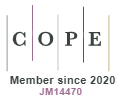Article Formatting
Resumo/Abstract - Descritores/Keywords
Resumo/Abstract:
The abstracts in both Portuguese and English should be written in a single paragraph, structured to include the following topics: Introduction, Objective, Methods, Results, and Conclusion. The abstract should contain between 100 and 250 words in both languages. References should not be used in the abstract.
Descritores/Keywords:
These are words or expressions that identify the content of the work. A minimum of 3 (three) and a maximum of 6 (six) descriptors should be provided, separated by semicolons, written in lowercase (except for proper names).
Only descriptors registered in DeCS (Descriptors in Health Sciences) and MeSH (Medical Subject Headings) are accepted.
Text Structure and Formatting Guidelines:
-
Document Format:
The text must be typed in a Word processor (DOC/DOCX format), using A4 paper size.-
Font: Times New Roman, size 12 pt.
-
Line spacing: 1.5 lines.
-
Total word count must comply with the category of the article (refer to specific guidelines).
-
Pages should be numbered sequentially, starting from the first page of the manuscript content.
- The title page must be attached separately from the main body of the article.
The title page must include the following information: title, authors, addresses, corresponding author, funding, and methodology – Download
-
-
Sections and Illustrations - See the Copyright Policy
-
Section numbers should be separated by a single space.
-
Illustrations should be inserted into the body of the text.
-
Figures, Graphs, Tables, and Images should be identified with titles and sources placed below them, except for tables, which follow IBGE guidelines.
-
Order of Presentation:
-
Titles, Abstract, Keywords
-
Main Text
-
References (in Vancouver format, single line spacing, font size 12, left-aligned) - examples
-
Appendices and Annexes (if any)
-
-
Text Sections:
-
Introduction:
Should present the purpose of the research, its relevance, describe the advancements made, its relation to previous works in the field, and identify limitations and potential biases. No data or conclusions from the study should be included here. -
Methods:
Should include the study design, hypotheses, outcomes, flowchart of the study, inclusion/exclusion criteria, and detailed characteristics of the material related to the research topic. The methods should be described clearly so that the study can be replicated. Standardized techniques must be referenced, and statistical analysis should be explained clearly. -
Methods: To ensure a blind review, any methodological information that could identify the authors must be included in the Title Page – Download
-
Results:
Should succinctly describe the new findings, following the same order in which the experiment was conducted as described in the "Methods" section. -
Discussion:
Interpret the results and relate them to existing knowledge, comparing them with previous studies. The limitations of the study should be addressed, and suggestions for future research should be made. -
Conclusion:
Should be concise and strictly based on the results of the research, answering the study's objectives. -
Acknowledgments:
If applicable, should be brief and concise. -
References:
-
Follow the Vancouver style for references.
-
In-text citations should be numbered sequentially, with Arabic numerals in superscript (e.g., diabetes, hypertension¹² and alcoholism⁴–⁹ are complex medical problems¹⁰).
-
List the names of the first six authors; if more than six, use "et al."
-
For journal abbreviations, use those from Index Medicus/ MEDLINE for international journals and LILACS and BBO for Brazilian ones.
-
Include DOI for electronic articles in the accessible format (https://doi.org/).
-
Personal communications and unpublished materials should not be included.
-
Authors must ensure the accuracy of the references, citing at least 60% from the last 5 years
- All references must be cited in the text, and all citations in the text must have a corresponding reference
-
Illustrations
Illustrations are considered any type of: tables, figures, graphs, charts, drawings, diagrams, flowcharts, photographs, maps, organizational charts, blueprints, portraits, etc., that serve to illustrate the research data.
The total number of illustrations accepted per article is 6 (six), including all the types mentioned above. Illustrations must be inserted within the body of the text, must have a title, and, if necessary, a caption.
Under no circumstances should a data table be repeated if the data are presented in an illustration. Statistical measures of variation (such as standard deviation, standard error) must be identified, and decimals in tabular data should be restricted to those with statistical and mathematical significance.
Photographic Illustrations: must be of professional quality in JPG or TIF format (300 DPI resolution and 10 cm in width), and must remain clear even after being reduced in size for publication.
Authors must ensure that nothing in the manuscript infringes upon any copyright or intellectual property rights of others, as they could be legally liable under the terms of Law No. 9.610/98, which consolidates the copyright legislation. Please refer to our Policy
Formatting the Document for Blind Evaluation
It is crucial to ensure that the identities of authors and reviewers are not revealed to each other during the evaluation process. This requires that authors, editors, and reviewers (who may submit documents to the system as part of the evaluation process) take precautions with the text and document properties:
For Microsoft Office documents, the author's identification must be removed from the document properties (in the menu File > Properties), starting from File in the main menu, and following these steps:
-
Click on File.
-
Select Info.
-
Click on Check for Issues.
-
Select Inspect Document.
-
Click on Inspect.
-
Under Document Properties and Personal Information, click Remove All.
-
After removing the information, close the pop-up window and save the document.
This ensures that all identifying information is eliminated from the document properties, maintaining a blind review process


